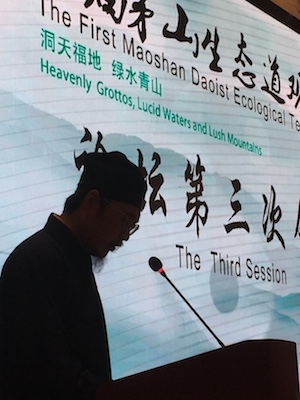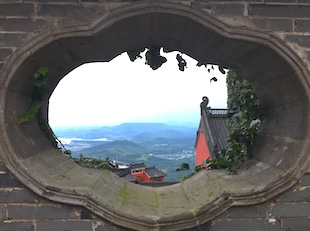Daoist eco plan bans rhino horn, ivory; addresses mercy release crisis
September 4, 2018:
 |
 |
 |
MaoShan Daoist temple has recently been rebuilt, looking over its spectacular valley |
No rhino horn. No ivory. No killing pangolins. An important new long-term environmental plan drafted by Chinese Daoist leadership includes guidelines that Chinese medicine should never use endangered animal parts.
It also recognises that the Heavenly Grottos (Dongtian) - specific sacred natural places, protected for generations as being places where one can, if skilled, walk between this world and the next - are precious and should be protected.
It also states that mercy release – set up to protect and release captive animals but which now causes greater suffering because it has become an industry in its own right – should be done with much greater care and wisdom, or replaced by appropriate charity donations.
Read more about the crisis in mercy release.
The draft plan was launched at the huge Daoist Ecological Temples Conference at Maoshan last month and is currently being discussed and agreed by the Daoist leadership.
 |
 |
 |
"Heavenly Grottos, Lucid Waters and Lush Mountains": the MaoShan conference was a Daoist celebration of the natural world and a plan to protect it. |
“Daoists should advocate the use of herbs as much as possible and avoid as much as possible the use of animal parts for medicine,” states the draft plan, which was prepared and debated by key Daoist temples in China and overseas as well as by the China Daoist Association. It is due to take effect in early 2019 and run through to the end of 2025.
“Daoist medicines and diet prohibit the use of endangered animals such as pangolin, which are protected by the Wildlife Law and listed as an endangered rare species. The Daoist community encourages temples to train Daoist doctors and believers on the laws and policies concerning the protection of wildlife in the country, as well as traditional Daoist values and raise public awareness and resist the illegal wildlife trade.”
The plan requests all Daoists and Traditional Chinese Medicine (TCM) doctors not only to avoid using rare animal products (which have been banned under Chinese law – rhino since 1993 and ivory since January 2018) but also actively to take steps against smuggling and poaching whenever they see it.
In addition: the Daoist community has called on believers to be rational and scientific when they conduct mercy release. Harmful mercy release will not only result in the death of the released animals themselves, but will also encourage the proliferation of the illegal wildlife trade. It may also lead to invasive species damaging the local ecology. Daoists should encourage believers to avoid mercy release when uncertain of the ecological consequences or replace mercy release with other forms of charity. Where possible, in cooperation with the local forestry and environment departments, Daoist temples can provide guidance and training to believers who carry out mercy release, and reduce the negative impact of mercy release on environment.
Other key pledges in the planOther important pledges by the Daoist community in the new Seven Year Plan include:
* Making the temples into ecological model demonstration sites using renewable energy (where possible feeding any extra to the grid); model sewage and rainwater systems; recycling of waste; tree planting and landscaping; low-carbon products.
* using the temples themselves and their teaching opportunities to allow followers and other monks in China and overseas, to learn about green lifestyles, and to understand why they are important for Daoists. All Daoist followers should be encouraged and taught (through lectures, stories and example) to live green and low carbon lives and avoid the waste of food.
* to promote and enable green transport and travel.
* set up eco information boards in every temple.
* encourage temples and believers to plant trees to increase forest carbon sinks as well as make the environment more natural.
* continue to promote a system where just three incense sticks are enough, and in this way (“civilized incense burning”) and other activities, reduce greenhouse gas emissions.
* assist local government to adapt to climate change in agriculture, forestry, and water resources, especially in ecologically fragile areas.
* protect natural landscapes around Daoist temples. Including cooperating with local forestry, resources, ecological and environment departments to strengthen the management of Daoist sacred mountains and holy sites, helping local authorities to implement mandatory protection for important ecosystems and species, and effectively protect rare and endangered wildlife, ancient trees, famous trees and natural habitats
* participate in building beautiful ecological villages and beautiful ecological towns including organic Chinese medicine nurseries, cultural tourism, and green tourism to help protect the local environment as well as to reduce poverty.
* join hands with other partners including local government, the business community (to promote environmentally friendly products and encourage TCM companies to use herbs not animal ingredients), local tourist departments, local farmers, volunteer teams, and also strengthen international cooperation.
In the context of today’s ChinaThe draft plan states that the environment and the wellbeing of the people are the necessary foundations of the future of China, and relates them to two key elements of the government’s plans under President Xi Jinping – the “Two Centenary Goals” and the “Realization of Chinese Dreams”.
The government has already led with a series of policies to promote environmental protection, green lifestyles and the “construction of Beautiful China”, and this new Plan by the Daoists is an important example of ecological leadership also coming from the faiths.
BackgroundDaoism teaches that there is a harmony between heaven, earth, and humanity, and it works to uphold the balance between yin and yang, exemplified by a harmony between humankind and nature.
In 2009, the Daoist Association of China agreed the First Eight-Year Plan for Environmental Protection (2010-2017) and adopted a series of measures including offering ecological education, building ecological temples, promoting healthy lifestyles, advocating green architecture, adopting resource management and encouraging green pilgrimage and tourism.
This followed on from the establishment of the Daoist Ecological Temple Network (DETN) in 2006 (with the help of ARC and the Valley Foundation/EMF. Since then it has spread to 28 provinces in China, with more than 200 member temples.
"ARC and the Valley Foundation have helped and supported this extraordinary initiative from the beginning, and are delighted to see how the Daoists are going far beyond anything that could have been imagined 14 years ago," said ARC's secretary general, Martin Palmer.
Today, as well as Daoist ecological temples there are Daoist ecological hotels, nurseries, roads and even entire cities.
The Daoist long term plan will be part of the discussios
LinksThe second Daoist draft plan in English
The first Daoist long term eco plan 2009-2017
The background to the faith eco plans
The crisis in mercy release
|

